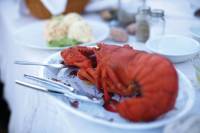Atlantic Canada – A Sensory Experience
The secret is out. The Maritime provinces of New Brunswick, Nova Scotia and Prince Edward Island along with beautiful Newfoundland and Labrador, are attracting more savvy travellers each year. It’s in these most easterly provinces where one discovers spectacular natural beauty sculpted over thousands of years by wind, water, and ice; and where one experiences colourful culture and language unique to each region, moulded over the centuries by indigenous peoples, European explorers, British settlers, Loyalists, and Acadians. With the waters of the Atlantic and its aquatic sub-basins lapping at the shorelines, a common thread found throughout the Maritimes and Newfoundland is the prevalence and importance of the fishing industry, a tangible influence in the everyday life of the friendly people who call these places home. A visit to Atlantic Canada is a delight for all of the senses.

Taking in the view atop Western Brook Pond Fjord, Newfoundland | Photo © Barrett & Mackay Photo
World-Renowned Eye-Catchers
UNESCO has officially recognized the significance of many Atlantic Canadian sites and natural phenomena. Who can deny the rich biodiversity and impressive forces of nature at work in the Fundy Biosphere Reserve; the glacier-carved fjords and otherworldly geology of Gros Morne National Park; or Nova Scotia’s postcard-perfect Lunenburg Waterfront? Birders in-the-know flock to the Bay of Fundy where millions of sea birds stop during their annual migration along the Atlantic Flyway; or to places like Grand Manan Archipelago and Witless Bay Ecological Reserve where puffins make their summer homes. Top it all off with spectacular whale-watching, colourful fishing villages and the awe-inspiring sight of giant icebergs making their way south through the waters of Iceberg Alley, and you have some pretty iconic imagery to feast your eyes upon on while exploring our east coast. As awesome as those sights are, it may be the stories of a fictional red-head that have attracted the greatest attention on a global scale. Anne of Green Gables captured the heart of audiences around the world, putting the familiar rolling green hills and fertile red soil of tiny Prince Edward Island on the proverbial map.

The Doucet House is significant to the history of the Acadian population of Prince Edward Island
All the Talk
If there’s one thing you can count on during your visit to Canada’s most easterly regions, it’s a whole lot of friendly conversation. Whether or not you can make out the words being spoken is another question. It’s not only the accents that might throw you off, Newfoundland and Labrador has so many of its own terms and expressions (literally thousands) that a dictionary was created specific to the province. Whadd’ya at, b’y? loosely translates to, How are you? or What are you doing?”. The language has been influenced primarily from 17th century England, Ireland, and Scotland mixed with some terminology from original Inuit and Mi’kmaq inhabitants. Head over to New Brunswick, Canada’s only bilingual province, and you may be welcomed with an unfamiliar form of French; that spoken by the Acadians (or Acadiens). Acadian French is closest to that spoken by Cajuns in the southern USA, as the two were born out of the same group of descendants of French settlers from the 17th century (the term Cajun is derived from the word Acadian). This form of French is also spoken in small pockets of Nova Scotia and Prince Edward Island, but these provinces are not officially bilingual. Here, you are more likely to notice the Gaelic influence with plenty of Celtic words and Scottish culture infused into everyday life. A great way to mingle with the locals on the islands of PEI and Cape Breton is by attending a ceilidh (pronounced ‘kay-lee’) which is basically a community-driven song-and-dance-filled party.
 Enjoy fresh lobster during your stay in New Brunswick | Photo courtesy of Guy Wilkinson
Enjoy fresh lobster during your stay in New Brunswick | Photo courtesy of Guy Wilkinson
A Taste of the Sea
The fishing industry has always been and remains a major economic activity in the Atlantic region. All of Atlantic Canada is famous for its mouth-watering lobster which is found in abundance in the Bay of Fundy and off the coasts of Prince Edward Island and Nova Scotia where you can even haul your own lobster trap alongside a bonafide lobster fisherman and then enjoy the fruits of your labour with a traditional Maritime lobster supper. Fundy’s intertidal zones are also the perfect environment for harvesting herring, gigantic sea scallops (delectible), and tasty little sea snails called ‘periwinkles’ which you may find in trendy Saint John restaurants (New Brunswick). In St. John’s, Newfoundland, you are sure to hear all about the cod fishing industry which has shaped the lives of generations of Newfoundlanders. A depletion of resources meant a ban on cod fishing (the infamous Codfish Moratorium), a dire hit to the economy, and a switch over to crab and shrimp stocks which became much more lucrative. Fortunately, in the past decade, cod has made a comeback and you will find many local fisherman now balance their seasons between cod, crab, and lobster - meaning a variety of deliciously-fresh options for the seafood lover.
Exploring Atlantic Canada by foot or by bike is the ideal way to immerse oneself into the heart of the region’s landscapes and culture. Friendly local hosts and fresh-air itineraries allow for optimal opportunities to treat your eyes, ears, and palate to all of the wonders that await in this spectacular corner of the earth.